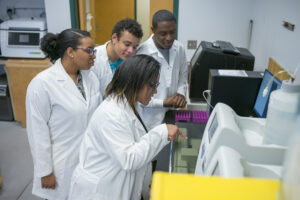
Ahja Harris is a fourth-year biology major at Florida A&M University who is one of a select number of students eligible in the STEM (science, technology, engineering and math) fields to receive future funding from a new five-year federal grant. The funding can provide more opportunities and resources for future STEM students.
FAMU announced recently that it had received a $30 million, five-year federal grant from the National Oceanic and Atmospheric Administration in an effort to help train the next generation of scientists of color within the Center for Coastal and Marine Ecosystems (CCME).
“I feel like with this grant it would pretty much open doors that were once closed before,” Harris said. “I have a financial burden and this grant would lessen that burden and give more opportunities.”
According to the official website, the National Oceanic and Atmospheric Administration (NOAA) is a national agency whose mission statement is to understand and to spread awareness of the protection needed to preserve nature while monitoring global climate and meteorology. NOAA created the Center for Coastal and Marine Ecosystems in 2016, which is guided by Florida A&M University and President Larry Robinson, who is serving as both the principal investigator of the project and center director.
In a press release, Robinson said, “Having underrepresented minorities who are experts not only enhances diversity but also ensures that we stay attuned to the needs of our most vulnerable populations as solutions are developed.”
Other partnerships from other minority institutions include Bethune-Cookman University, California State University Monterey Bay, Jackson State University, Texas A&M University-Corpus Christi, and the University of Texas Rio Grande Valley.
The mission statement of CCME is to instruct and educate the next generation of scientists, specifically from minority communities. The agency applies to students matriculating within STEM and a social science which is pertinent to NOAA while practicing research in oceanic and coastal communities.
The NOAA CCME focuses on three scientific research areas. Each has a distinct objective in reaching the goal of CCME: Costal intelligence, coastal resilience, and place-based conservation. Each area, despite being different, has a common purpose — studying natural infrastructures while using the necessary resources to address the various effects that impact society.
FAMU’s vice president of research, Charles Weatherford, said in a release that the grant is a representation of the various research that is conducted at FAMU.
“This is FAMU’s largest grant,” Weatherford said. “The center is a consortium of minority serving institutions and was formed to address issues confronting marine and coastal communities and to help supply a modern talented workforce in relevant NOAA areas of interest.”